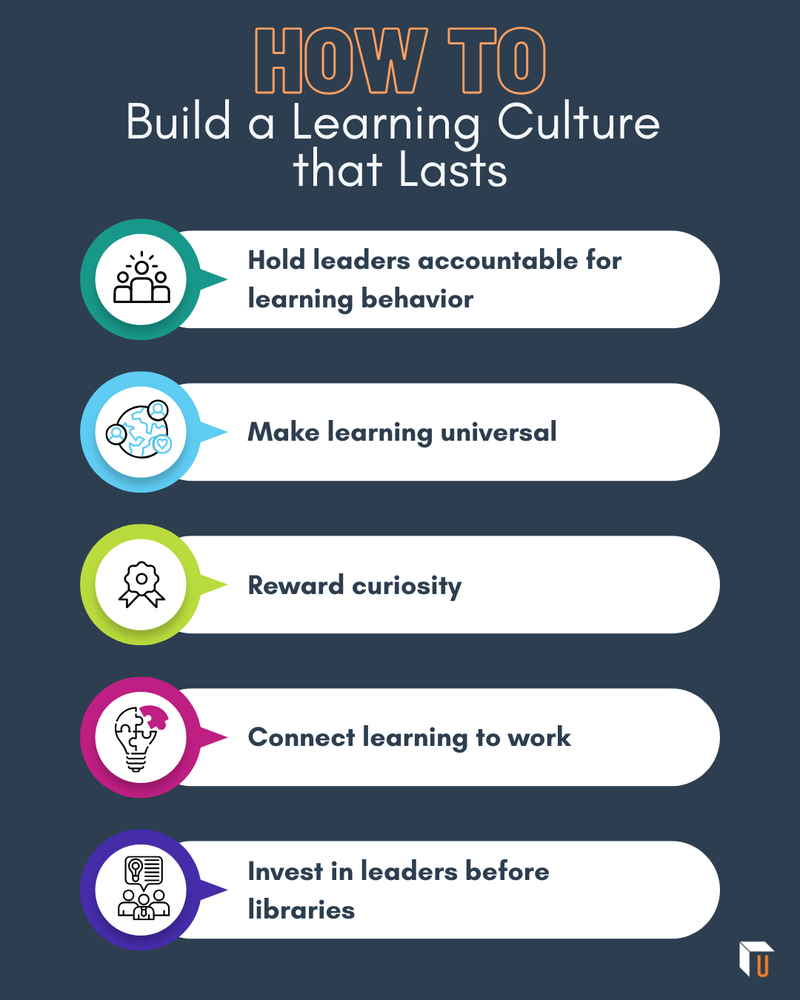Creating a Culture of Learning Is Not About the Quality of Your Content

This post explores why your culture and not your content is more of a driving force as to whether learning actually sticks, and what you can do to change it.
Every year, organizations pour resources into new learning trends. Each quarter brings another lineup of platforms, digital libraries, and in-the-flow-of-work tools that promise to “change everything.” Budgets rise, dashboards fill with activity, but engagement rarely changes. Employees click, complete, and move on. The problem isn’t the ‘shine’ of the content but the pulse that drives it.
The learning and development world has a soft spot for novelty. AI-curated playlists, bite-sized modules, and corporate “streaming” experiences promise training miracles through convenience. Yet the research keeps pointing to something quieter and more human. Technology can enhance learning, but culture decides if it takes root.
The Real Foundation of Learning Culture
You’ve heard it before: Culture eats strategy for breakfast. The best strategy (or shiniest new platform) will fail if the ecosystem doesn’t support it. And no one has ever been able to package up learning culture as a product (at least not yet). That’s because real learning cultures grow in the spaces where leaders model curiosity, invite questions, and respect learning as work worth doing.
A culture of learning depends on whether people feel supported, encouraged, and backed by leaders who put their time, money, and trust behind development. Without psychological safety and real commitment from leadership at all levels of an organization, even the most dazzling courseware won’t stick.
A 2023 Gartner study found that organizations with strong learning cultures improved employee skill preparedness by 56 percent, regardless of how new or polished their content was (Gartner, 2023). The difference came from leadership behavior, access to opportunities, and consistent communication from the top. The American Psychological Association’s 2024 Work in America survey reached a similar conclusion: employees who describe their workplace as psychologically safe report higher engagement, greater productivity, and more willingness to learn (APA, 2024). These results make it clear that learning culture grows from climate and leadership, not content quality.
Leaders set the emotional tone that shapes how people act. When a manager treats training like a formality, employees learn to treat it the same way. When a leader talks about what they are learning, or admits where they are unsure, that honesty opens the floor for everyone else. Gallup’s research shows that managers account for roughly 70 percent of the variance in employee engagement, which remains one of the best predictors for learning and retention (Gallup, 2015). People learn most in places where leaders value growth and show it in plain view.

How to Build a Learning Culture That Lasts
A real learning culture lasts longer than any software contract. It takes intention, patience, and leaders who are accountable for the example they set.
- Hold leaders accountable for learning behavior. Track how often coaching happens, how often feedback flows, and whether people feel free to ask questions. Make it a habit for leaders to ask their teams, “What did you learn today?”
- Make learning universal. Remove the velvet ropes. Give every employee time, access, and relevance so learning feels like part of their day, not a perk for a few.
- Reward curiosity. Recognize people who share lessons, test new ideas, and create feedback that lifts the group higher.
- Connect learning to work. Track how knowledge turns into new skills, projects, or promotions. Learning should lead somewhere visible. Measure growth instead of just completion.
- Invest in leaders before libraries. Equip managers to model growth. One leader who learns out loud can shift an entire team’s attitude toward development.
One striking real-life example of how empowering leadership to create a culture of learning was made manifest when Satya Nadella took over as CEO of Microsoft in 2014 and inherited a “cultural mess” (HBR, 2024). Instead of perpetuating the status quo of politicking and internal competition, he deliberately shifted the culture so that leadership changed how they modelled learning.
How?
Among many cultural shifts, Nadella and his team modelled and empowered leaders to admit what they didn’t know, presented senior leaders as resources for learning, give feedback in ways that promoted learning and future success, encouraged experimentation, and focused on growth. That behavioral shift helped embed learning in the way the company worked, not just in what training was delivered. The initiative was successful, resulting in significant exponential growth over the next 9 years. In Nadella’s own words, “I told my colleagues that I was not talking bottom-line growth. I was talking about our individual growth. We will grow as a company if everyone, individually, grows in their roles and in their lives” (HBR, 2024).
Looking Ahead
At its core, a learning culture begins and ends with leadership. Leaders write the emotional rhythm for their teams. When they treat growth as a daily habit, people fall in step. When they show openness and curiosity, others mirror that behavior. The strongest learning programs start with leaders who live the lessons they want others to learn.
The next chapter of workplace learning will be defined by how leaders behave, not by which platform wins. The future belongs to organizations where curiosity feels safe, where questions aren’t punished, and where learning sits in the rhythm of the workday.
When leadership behavior, psychological safety, and access move together, learning becomes part of the organization’s heartbeat. That rhythm keeps people engaged, connected, and ready for whatever comes next.
Sources & Further Reading
- Gartner (2023): State of the Learning Culture Report. Leadership and access drive 56% higher skill preparedness.
- APA (2024): Work in America Survey. Psychological safety drives engagement and learning.
- Gallup (2015): State of the American Manager. Leadership explains 70% of engagement variance.
- HBR (2024): Culture Transformation at Microsoft


